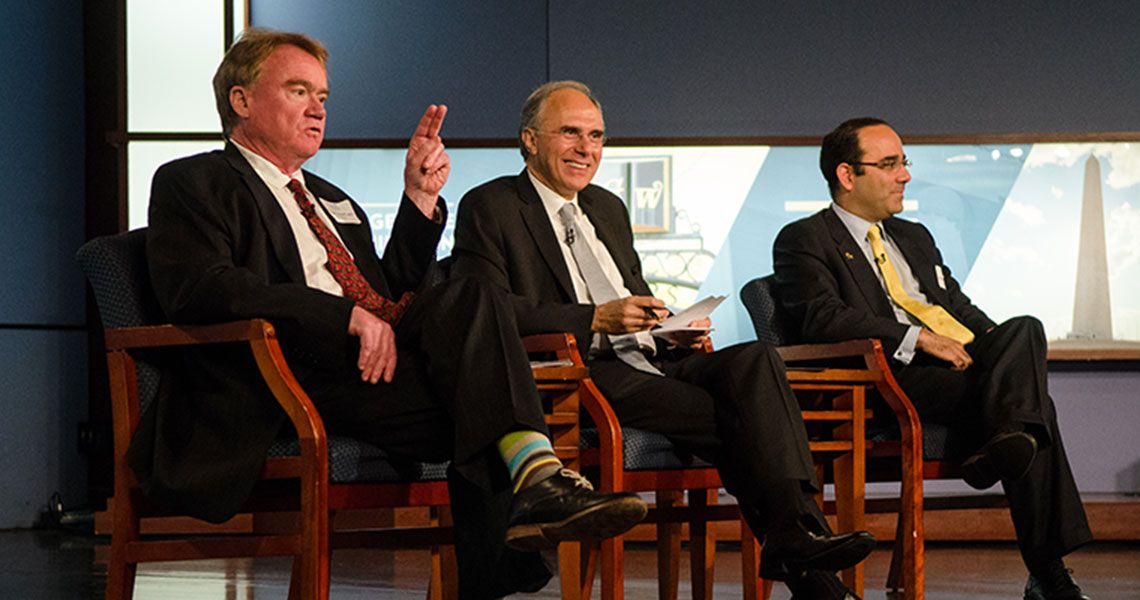During NASCAR events, a ten second pit stop is all it takes for a car to have four wheels changed, its gas tank refilled, and a damaged windshield torn off. “If they can do all that in ten seconds, then we can put in a chest tube and IV in 15 minutes,” said Babak Sarani, M.D. ’97, RESD ’04, associate professor of surgery and chief of trauma and acute care surgery at GW’s School of Medicine and Health Sciences (SMHS).
During a June 9 lecture, titled “Great Saves: Advances in Trauma and Critical Care Medicine,” Sarani shared the mantra of the trauma service with an audience of D.C. metropolitan community members. “In 15 minutes, we will do anything necessary to stabilize you and we will leave the emergency room. We might be going to the operating room or to radiology or to intensive care, it depends. But wherever we go, we’re no longer in the emergency room after 15 minutes.
Sarani, along with his colleague Michael G. Seneff, M.D., associate professor of anesthesiology and critical care and associate professor of surgery at SMHS and director of the intensive care unit at GW Hospital, discussed exciting advances in trauma and critical care, including new techniques and resources that are increasing the likelihood of survival and recovery. The lecture was part of the Frontiers in Medicine series, which has connected community members with renowned heath care experts since its inception in 2011.
Anton Sidawy, M.D., M.P.H., Lewis B. Saltz Chair of Surgery at SMHS, who moderated the evening, noted that last November, GW Hospital gained verification as a Level 1 Trauma Center through the American College of Surgeons, meaning that it is capable of providing around-the-clock evaluation and treatment for any injury — from prevention through rehabilitation. “The cases our two speakers are going to present, these patients who were able to return to their daily lives, are nothing short of miracles,” Sidawy said.
One such miracle came in the form of a male in his 20s who suffered traumatic brain injury (TBI) in an automobile rollover. The GW trauma team was able to stabilize him but, due to a massive amount of vomit in his lungs, within three days of the accident he was unable to breathe on a mechanical ventilator. The team decided that the only chance of saving the patient’s life — Sarani referred to it as a “Hail Mary pass” — was to use a rare technique called extracorporeal membrane oxygenation (ECMO), which provides cardiac and respiratory support by draining the blood from the venous system and oxygenating it outside of the body.
The patient was on ECMO for 20 days — the longest reported period at that time — and he responded so well that he made a complete recovery. “I’m happy to report that he’s now an undergrad in college, and is busy chasing girls when he should be studying more,” Sarani joked. “He is an example of why ‘we cannot’ is simply not an option in trauma care.”
Seneff closed the evening by sharing a number of statistics, including that the mortality rate from head trauma requiring surgery dropped from 25% to 12% between 1988 and 2012. “Critical care medicine deserves some of the credit here,” Seneff said. “It’s a relatively new, multidisciplinary specialty that treats the severely injured, complicated, or specialized post-op patient who might need specialized services such as mechanical ventilation, blood pressure monitoring, etc.”
But Seneff reports that the number of people who sustain head trauma is still staggering. “There are 5.3 million Americans living with some form of disability from a TBI. That’s 2% of the population — a huge number.” 1.5 million more Americans will sustain a TBI this year, a number that he says dwarfs the incidence of most other illnesses the media reports on.
Sarani echoed Seneff’s concerns, noting that trauma is the leading cause of death in those under age 45. “These are young, productive citizens,” he said. “Rescuing them is imperative for the wellness of our nation.”



